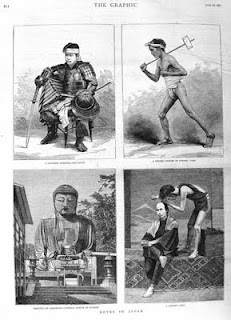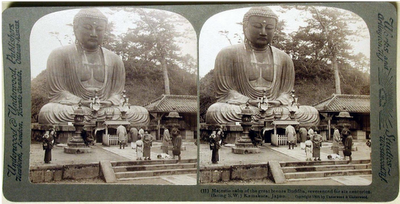 |
| Recto |
 |
| Verso (detalle caligrafía y sello) |
Author: Shimooka Renjo, born as Sakurada Hisanosuke, opened one of the first commercial photography studios in Yokohama, and was a rival of
Ueno Hikoma in Nagasaki. Learning photography from the American captain John Wilson, Shimooka opened a studio in Yokohama in 1862. He became very prosperous selling tourist and portrait photographs, and was one of the creators of the "Yokohama Shashin" photography of tourism. In 1867 he opened the new Zenrakudo studio in Yokohama, and took on many apprentices. Retiring in 1876, he relinquished his business to his son.
Biografía ampliada en
Photoguide Japan.
Cartes-de-visite: 1 card; 10 x 6.2 cm
Title: Title devised by Henry and Nancy Rosin
Handwritten on verso: "Diboots. The largest idol in the world. It can be seen a little outside of Yokohama. 1873."
Printed on verso: "Renjio Yokohama," Japanese characters also present
Fuente: Henry and Nancy Rosin Collection of Early Photography of Japan 1860 - ca. 1900. Freer Gallery of Art and Arthur M. Sackler Gallery Archives.
Smithsonian Institution, Washington, D.C. Partial purchase and gift of Henry and Nancy Rosin, 1999-200
Observaciones: Es interesante observar cómo la vegetación del fondo es muy frondosa. Destaca ya el árbol derecho en el fondo que se repetirá en las imagenesde la década de 1880.
Ueno Hikoma Award (otorgado por la
Kyushu Sangyo University):
Ueno Hikoma (1838-1904), the “father of Japanese photography”, who took this photo. He was a pioneering photographer in Japan. After studying chemistry at Nagasaki Igaku Denshusho (Nagasaki Medical Institution), he learned photography from Mr. Rosch, a French photographer Pierre Joseph Rossier (bio en Wiki). Then, in 1862, the 2nd year of the Bunkyu period, he opened Ueno Satsueikyoku (Photo Studio Ueno), the first photo studio in Japan. Many famous people, including Sakamoto Ryoma, Katsu Kaishu and Takasugi Shinsaku, went there, and the studio became famous. His photos convey many important historical images to our modern world. (Kyushu Sangyo University)

















































